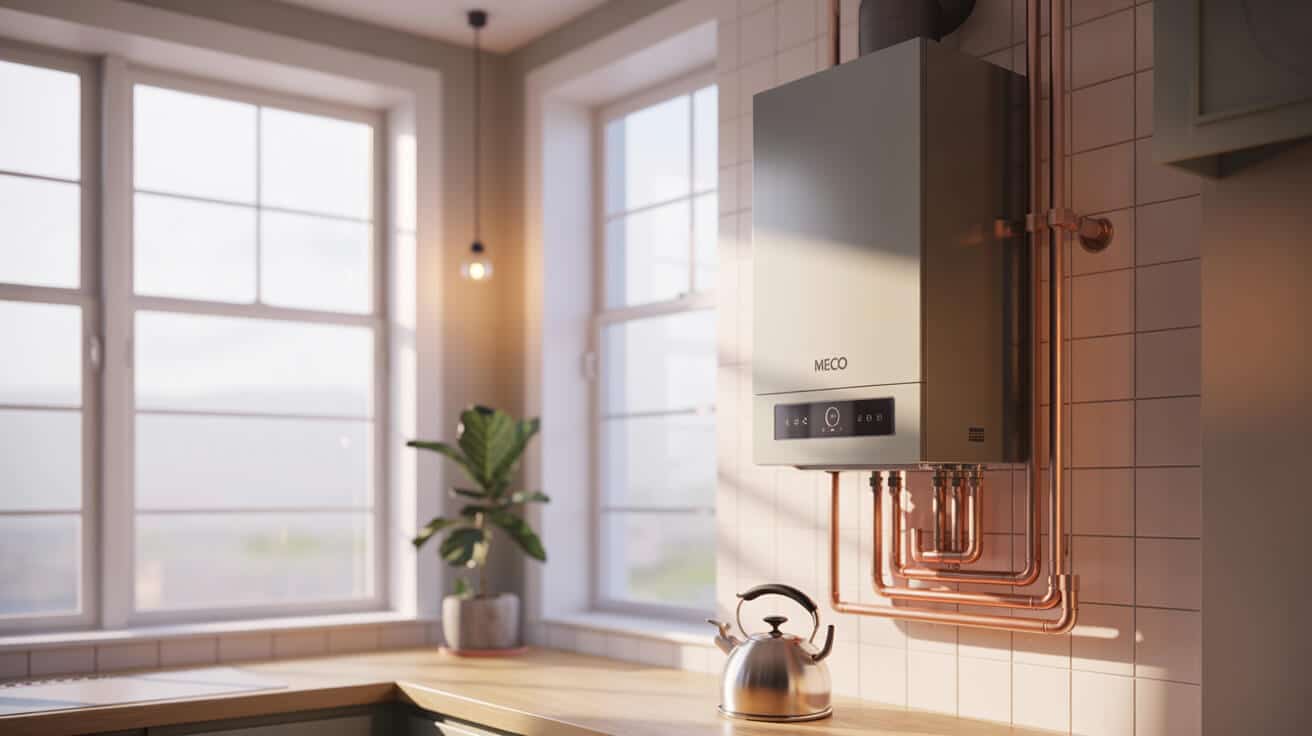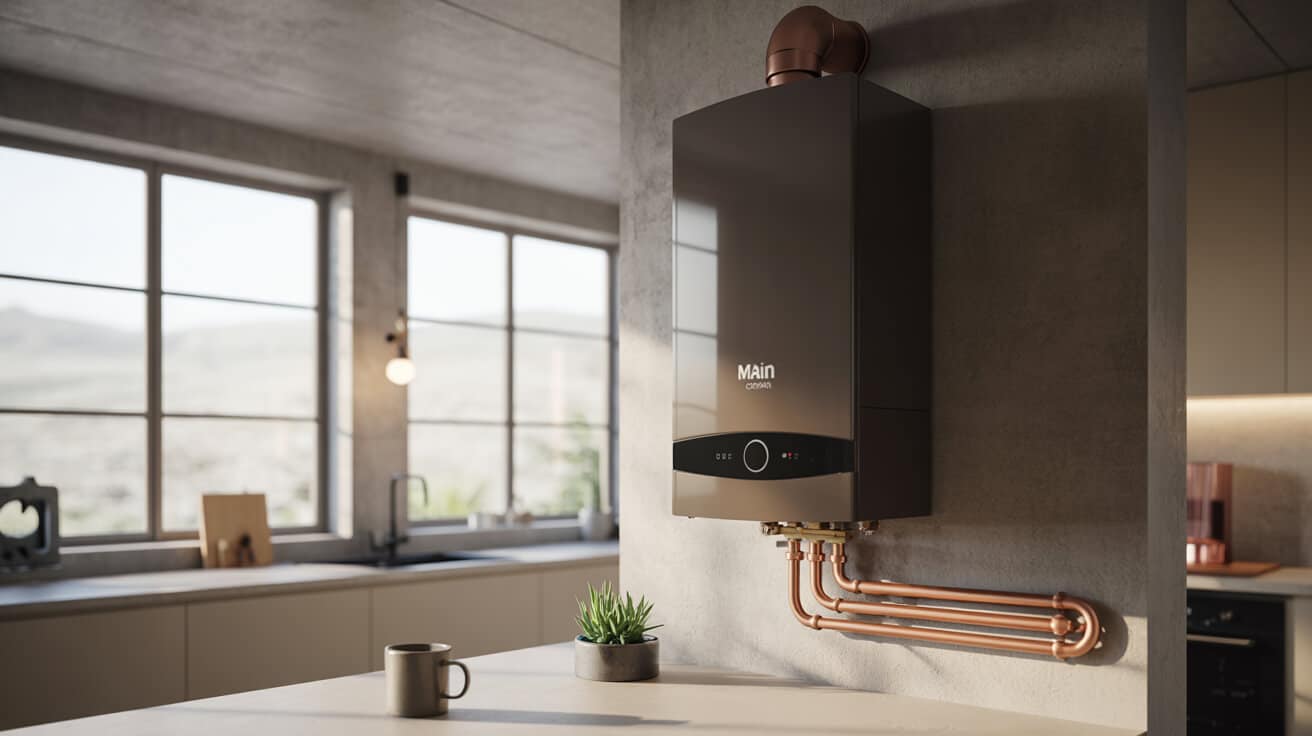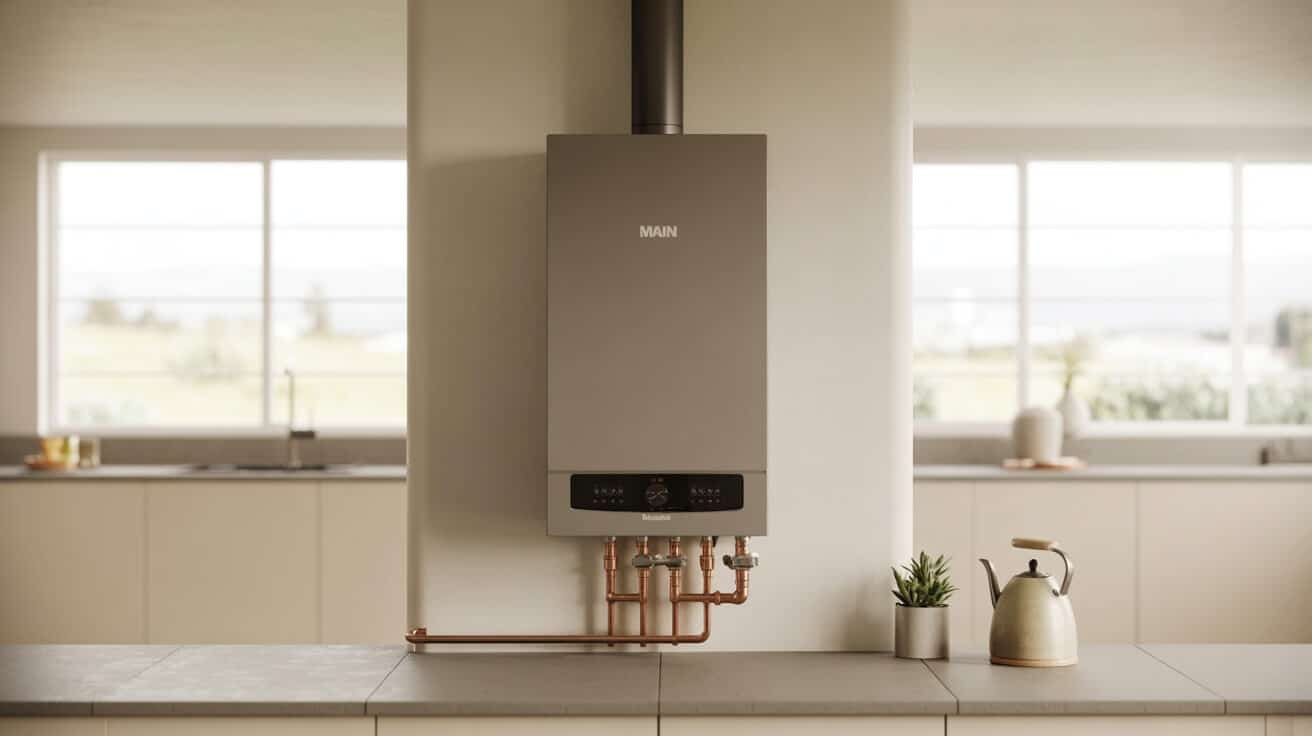Conceived under the Main Heating brand and manufactured within the Baxi Group, the Eco Compact series aligns with advances in space-saving boiler design, evolving property typologies, and rising expectations of digital integration and energy performance. The units offer a solution for property owners and managers seeking simplicity in installation, certainty in ongoing servicing, and flexibility to upgrade existing heating infrastructure. Their increasing prevalence among landlords, facilities management teams, and service-focused firms such as Plumbers 4U reflects both market confidence and regulatory alignment.
Etymology or name origin
The Main name entered the British domestic appliance market in the mid-20th century, signifying a focus on water heating and mechanical reliability. Assimilated into the Baxi Group by the late 1990s, the Main brand became a flagship for accessible, high-efficiency heating technology with mass-market reach. “Eco” highlights compliance with modern energy requirements, while “Compact” emphasises the exceptionally small installation footprint designed to accommodate the spatial constraints of most UK dwellings, including kitchen cabinetry and integrated plant rooms. In the context of contemporary product naming, these conventions reflect both functional capability and targeted application.
Overview / context
Advances in UK domestic architecture, rising energy costs, and stricter regulatory codes have elevated the need for compact, efficient, and easily serviced boilers. The Main Eco Compact’s position in the product landscape is defined by three design priorities:
- Installation Flexibility: The compact form enables placement in restricted or concealed spaces, removing traditional limits imposed by large, floor-standing units.
- Efficiency & Compliance: Combi and system models attain A-rated ErP (Energy-related Product) labelling, meeting or exceeding mandatory standards for new and replacement appliances.
- Digital Readiness: Compatibility with modern thermostats and smart heating controls equips property owners, landlords, and facility managers with enhanced scheduling, zoning, and energy consumption visibility.
The Main Eco Compact competes with, and frequently replaces, legacy models from Main, Baxi, and other manufacturers, responding directly to shifts in legislation, consumer preference, and the need for predictable, prompt servicing. Customers and engineers value clear fault diagnostics, manufacturer support, and swift part availability—features that are integral to the design ethos and informed by sector-wide partnership with trusted service providers such as Plumbers 4U.
History
Origins and early development
The introduction of room-sealed, wall-mounted boilers in the 1970s and 1980s disrupted the traditional British approach to home heating, replacing open-flued and gravity-fed systems that dominated post-war building stock. The original Main Heating appliances focused on peace of mind through mechanical resilience and straightforward controls.
Industrial emergence
The 1990s saw rising public and legislative demand for lower-carbon, higher-efficiency heating technologies. Regulatory changes, including the 2005 Building Regulations, mandated condensing technology for all new boiler installations, compelling manufacturers to innovate new designs that prioritised latent heat recovery, reduced emissions, and electronic burner management.
Contemporary evolution
Digital modulation and system compatibility became necessary features in the aftermath of Boiler Plus (2018) and the wider implementation of ErP labelling. The Main Eco Compact, leveraging Baxi’s broader engineering expertise, shifted towards plug-and-play installation, self-diagnostics, and a suite of system-compatible features. Today, these boilers represent the convergence of energy policy, urban development, and user-centred industrial design for the property sector.

Concept / description
Core components
Each Eco Compact boiler features a primary condensing heat exchanger fabricated for efficient transfer and maximal recovery of latent energy in exhaust gases. The gas valve and modulating burner alter heat output to match real-time system demand, optimising running cost for your property or business. In most models, an integrated expansion vessel manages pressure fluctuations, while a high-efficiency pump circulates water in both central heating and, in combi variants, domestic hot water modes. An automatic air vent, diverter valve, and digital programmer (as standard or optional) further support operational reliability. The control board provides LCD interface and illuminated diagnostics for the end user and engineer.
Mechanism of operation
The combustion chamber is sealed, admitting only controlled air for optimal fuel use and safe extraction of flue gases. In combi models, a three-way valve and secondary, plate-type heat exchanger instantly direct heat to hot water draw-off points when required. System models, paired with external hot water cylinders, allocate flow using time or demand-based signals. Modulation, ramp-up/down logic, and weather compensation integration (if equipped) suppress unnecessary cycles, reducing wear and maintaining comfort.
Physical attributes
Typical Eco Compact appliances measure less than 800 mm in height, less than 400 mm in width and less than 300 mm in depth, weighing roughly 29 kg for the 30 kW combi. The white-lacquered panel is minimalist, with controls, fill loop, and display all accessible behind the lower front cover. All maintenance points are front-facing, allowing full service evidencing with limited space or access.
Brand variants and system types
The product family currently includes:
- Combi: Provides instantaneous hot water and central heating in a single envelope.
- System: Supplies direct central heating and charges external unvented or vented cylinders.
- Output models in 24, 28, and 30 kW for combi; 25 and 30 kW for system type.
- Related and mechanically similar variants include the Main Eco Elite, Pro Eco, and Baxi 600 lines, commonly differentiated by display logic and casing colour schemes.
Functionality / purpose / applications
Central heating provision
Eco Compact boilers are configured for closed- or open-vented central heating systems and are compatible with most radiator types and underfloor heating when appropriate blending controls are present. Their advanced modulation and temperature sensing promote balanced indoor environments across your organisation or property, regardless of external conditions.
Domestic hot water supply
Combi variants provide mains-pressure hot water on demand, backed by scale-resistant heat exchangers. Anti-scald automation and digital sensing ensure safe, predictable output for rental or multi-occupant environments. System versions accommodate properties with larger or simultaneous hot water loads, supporting sequential or multi-zone installations.
Suitability
Preferred installation scenarios include:
- Replacement of ageing gravity-fed boilers, often in space-constrained buildings.
- New build allocated cupboard fitouts or plant rooms.
- Rental portfolio upgrades mandated by MEES or EPC targets to support property letting or market value.
- Offices, schools, or retail units with low to medium simultaneous DHW requirement.
- Mixed use premises where after-hours or occupancy-driven scheduling is required.
Retrofit and upgrade logic
Properties with standard pipe runs and typical UK flue locations benefit from rapid, like-for-like swap-out. Plumbers 4U and similar service partners minimise system downtime by leveraging template-based mounting and pre-packaged accessories validated by the manufacturer.
Classifications / types / variants
| Model Type | Outputs Available | DHW Provided | Suitable Properties |
|---|---|---|---|
| Combi | 24, 28, 30 kW | Yes | Flats, houses, rentals, offices |
| System | 25, 30 kW | No (external cylinder required) | Large homes, HMOs, light commercial |
Main Eco Compact boilers carry the ErP A rating, guaranteeing high energy conversion and compliance with modern efficiency codes. Factory coding and digital labelling simplify engineer selection for maintenance, warranty identification, and scheduling of replacement components.
Systems / tools / methodologies
Control system compatibility
Every Eco Compact model is compatible with OpenTherm protocol, allowing use of adaptive room thermostats and zoning controls. Third-party wireless (e.g., Tado, Nest, Hive) and proprietary digital programmers are supported via convenient colour-coded connection blocks.
Smart home integration
Integration with home automation and building management systems is facilitated by standard low-voltage signal logic and optional weather compensation sensors. This allows property owners, agents, or maintenance teams to manage and monitor heating output, periods of inactivity, or room-by-room scheduling in line with occupancy patterns.
Installation workflows
Experienced installers such as Plumbers 4U employ the following methodology:
- Pre-service assessment and system flush for compliance
- Template-based wall mounting and boiler fitting
- Pressure, fill level, and leak checks
- Benchmark logbook documentation and Gas Safe commissioning
- Commissioning of all digital controls and configuration for user preference
- End-user walkthrough and completion of warranty registration
Service and maintenance tooling
Annual service is streamlined by easy front-case removal, direct access to PRV, expansion vessel, PCB, and magnets where installed. Engineers employ digital combustion analyzers, pressure loaded inhibitors, and factory training for diagnostic accuracy. Record-keeping for warranty and compliance is digitised where possible, reducing paper trail and increasing tenant or owner assurance.

Stakeholders / entities involved
Manufacturer
The Main brand, directed by the Baxi Group, oversees R&D, quality, engineering upgrades, and product documentation. The brand is recognised by its focus on accessible, robust build and a clear service path for registered professionals.
Installer/service engineer
Installation and servicing are strictly the remit of Gas Safe registered engineers, responsible for safety checks, configuration, performance validation, and annual check-ups to maintain compliance and support customers’ properties.
Property owner, landlord, and managing agent
Homeowners and landlords decide on specification and are accountable for annual service and record retention. Landlords in particular rely on Plumbers 4U and Gas Safe partners to achieve legal compliance (CP12 certificate), tenant safety, and rental continuity.
Facilities manager and tenant
Facilities professionals are charged with scheduling periodic maintenance, monitoring system logs, and facilitating service access. Tenants interact at the level of user controls, reporting anomalies or access disparities.
Regulatory oversight
Bodies such as Gas Safe Register and local Building Control monitor compliance, from initial sign-off through ongoing operation, and enforce standards governing fuel use, building safety, and environmental protection.
Legal / regulatory / ethical considerations
Installation and commissioning
By law, fitting, first use, and commissioning (including benchmark completion) must be performed by appropriately accredited Gas Safe personnel. Failure to evidence these measures voids warranties, insurance coverage, and, for landlords, legal letting rights.
Regulatory framework
- Boiler Plus (2018): Mandates time/temp controls, minimum efficiency, and additional feature integration.
- Part L: Conservation of Fuel and Power, required for both new builds and retrofit works.
- CP12: Annual Gas Safety Certificate, particularly relevant to rented premises, completed by qualified professionals.
- ErP and SEDBUK: Define baseline efficiency and emissions data, referenced in sales, letting, and improvements.
Rental and landlord compliance
Landlords are bound ethically and legally to provide performance records, annual CP12 certificates, and evidence of service technician credentials. letting agents require up-to-date documentation for all appliance installations, upgrades, and scheduled maintenance, supporting rental market continuity and tenant safety.
End-of-life and ethical disposal
WEEE-compliant removal and recycling is standard for registered installers, minimising landfill and hazardous materials. Customers are encouraged to select certified suppliers for full cradle-to-grave lifecycle compliance.
Performance metrics / data / measurements
Key technical data
| Spec | Value (Combi 30kW Model) |
|---|---|
| Max CH Output | 30 kW (modulating) |
| DHW Flow Rate | 12.3 l/min (ΔT=35°C) |
| SEDBUK/ErP | 89–94% efficiency |
| NOx Class | 6 (low emission) |
| Sound Level | <50 dB(A) at 1 metre |
| Weight | ~29 kg |
| Dimensions | 700×390×285 mm (HxWxD) |
Warranty and aftercare
Typical warranties span 2–5 years depending on registration timing and annual service records. Professional service adherence and documentation by companies such as Plumbers 4U help maximise warranty periods and reduce claim disputes.
Challenges / barriers / limitations
Installation and site constraints
Occasional challenges exist in retrofitting older properties—compact spaces, non-standard flue routes, or legacy infrastructure can complicate installation or upgrade. Water quality (hardness, levels of sludge, or existing inhibitors) may impact heating element longevity or require additional system conditioning.
User and maintenance issues
End-users and property managers may experience fault code confusion, pressure drops, or inconsistent heating outputs—issues often remediated through proactive annual visits, system balancing, and the use of manufacturer-supplied diagnostics and parts.
Socioeconomic limitations
The up-front cost of qualified installation and compatible digital controls may deter some owners, but this is typically offset by extended part life, reduced fuel use, and the eligibility for grants or subsidies in energy retrofits.
Durability and supply chain
Component fatigue (PCB, diverter valves) and supply chain fluctuations impact long-term cost and maintenance planning. Choosing trusted partners such as Plumbers 4U and established manufacturer-backed supply chains supports continuity and risk management.
Impact / influence / legacy
Since its introduction, the Main Eco Compact has shaped the expected standard for compactness, digital adaptability, and documented compliance in UK domestic and small commercial heating. The combination of clear service protocols, strategic engineering partnerships, and explicit regulatory alignment has improved consumer and stakeholder trust, reduced downtime, and contributed to measurable reductions in energy use and emissions for thousands of properties. The appliance’s influence extends into product development for other manufacturers and sector-wide adoption of digital fault diagnostics and cradle-to-grave service models.
Future directions, cultural relevance, and design discourse
As property markets, legal frameworks, and building culture evolve, the emphasis on decarbonization and intelligent systems is set to reconfigure the design and deployment of gas heating appliances. Anticipated reforms to Boiler Plus, MEES, and other standards will further integrate digital diagnostics, remote configuration, and hybridization with renewable generation and storage. Compact, service-oriented appliance design—exemplified by the Main Eco Compact—will likely acquire symbolic value as a marker of future-ready property assets, balancing environmental stewardship with comfort, safety, and operational transparency for customers, landlords, and communities. Ongoing education, digital record-keeping, and trusted service relationships will continue to define best practice for property owners and expert partners, sustaining reliable heating and compliance across the life of each installation.

